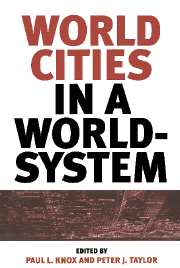Book contents
- Frontmatter
- Contents
- List of contributors
- Preface
- Part 1 Introduction: world city, hypothesis and context
- Part 2 Cities in systems
- 5 Cities in global matrices: toward mapping the world-system's city system
- 6 World cities, multinational corporations, and urban hierarchy: the case of the United States
- 7 Transport and the world city paradigm
- 8 The world city hypothesis: reflections from the periphery
- 9 Global logics in the Caribbean city system: the case of Miami
- 10 Comparing Chicago, New York, and Los Angeles: testing some world cities hypotheses
- 11 ‘Going global’ in the semi-periphery: world cities as political projects. The case of Toronto
- Part 3 Politics and policy in world cities: theory and practice
- Appendix The world city hypothesis
- Index
7 - Transport and the world city paradigm
Published online by Cambridge University Press: 07 October 2009
- Frontmatter
- Contents
- List of contributors
- Preface
- Part 1 Introduction: world city, hypothesis and context
- Part 2 Cities in systems
- 5 Cities in global matrices: toward mapping the world-system's city system
- 6 World cities, multinational corporations, and urban hierarchy: the case of the United States
- 7 Transport and the world city paradigm
- 8 The world city hypothesis: reflections from the periphery
- 9 Global logics in the Caribbean city system: the case of Miami
- 10 Comparing Chicago, New York, and Los Angeles: testing some world cities hypotheses
- 11 ‘Going global’ in the semi-periphery: world cities as political projects. The case of Toronto
- Part 3 Politics and policy in world cities: theory and practice
- Appendix The world city hypothesis
- Index
Summary
Introduction
The world city paradigm posits a distinct role for certain cities in articulating regional and national economies in the global system (Friedmann 1986). World cities develop hierarchical relationships that rise and fall over time according to their control and mediary functions in the system. As commanding nodes in the world economy, world cities are defined by dense patterns of interaction between people, goods, and information. A rapidly expanding and sophisticated global network of transport services and infrastructure facilitates this interaction. In turn, the globalization of finance, production, labour, service, cultures, and information has given impetus to, and has helped to shape, extraordinary advances in transport provision. Thus, the role of transport in the evolving world city system is both crucial and fundamental.
Although much research has addressed world city formation and the genesis, growth, and change of the world city system, we still do not have a clear appreciation and understanding of either the dynamics or the role of transport in shaping world cities. Few studies have examined theoretically or empirically how, why, or where transport linkages function in the world city system. Moreover, little attention has been paid to the way control and mediary functions of world cities are helping to shape global, regional, and local transport networks and services.
- Type
- Chapter
- Information
- World Cities in a World-System , pp. 115 - 131Publisher: Cambridge University PressPrint publication year: 1995
- 81
- Cited by

